181
combined and content 2 corresponding to the
combined content on FM1 is recalled on FM2.
– If content 1 of combined cont
ent is recalled on FM1
and other content is recalled on FM2, a message
appears. If you press [OK], the content recalled on
FM2 is released, the channels are combined and
content 2 corresponding to the combined content on
FM1 is recalled on FM2.
– In all other cases, when content is recalled on FM1 or
FM2
, a message appears. If you press [OK], the
recalled content is released, the channels are
combined, and both FM1 and FM2 become black
signals.
• If group mode is disabled while combined content is
recalled
on FM1 and FM2, a message appears. If you
press [OK], the channels are uncombined, content 1 of
the combined content remains recalled on FM1, content
2 recalled on FM2 is released, and FM2 becomes a
black signal.
Locking a frame memory output channel
You can lock a frame memory output channel when still
image content or video content is recalled on the frame
memory output channel.
The following operations are inhib
ited on a locked frame
memory output channel.
• Recalling content
• Creating content (freeze, record)
• Enabling/disabling audio
The following operations are inhibit
ed for content
recalled on a locked frame memory output channel.
• Trimming video content
• Unloading content
To lock FM1, set the [Output Lock] switch for [FM1] to
the on
state in the following menus.
• Home > Frame Memory > FM
1/FM2 > Clip/Still >
Recall menu (13101.11)
• Home > Frame Memory > FM1/FM
2 > Clip/Still > Play
menu (13101.12)
• Home > Frame Memory > FM
1/FM2 > Clip/Still >
Record menu (13101.13)
Frame Memory Content Operations
For details about displaying and selecting content, see
“Content Operations” (page 348).
Loading content
You can load content into frame memory from content
storage.
• Only video content with a frame rate the same as the
system freque
ncy or a frame rate half the system
frequency can be loaded.
• If the system signal format is different
than the image
size, the following processing occurs with the origin at
the top left of the image.
– If an image size is smaller, the missing part is filled
wi
th black.
– If an image size is larger, the excess part is cropped
an
d removed.
Even when image size processi
ng occurs, the thumbnail
image is not changed.
1
Open the Home > Frame Memory > FM Common >
Load/Save > Load menu (13109.21).
Content can be displayed in list view or thu
mbnail
view.
2
Select content to load.
To select and load multiple
content, place a check
mark beside the target content to load.
To select and load all displayed content, place a check
m
ark in the Select All checkbox.
3
Press the [Load to Memory] button.
4
Check the message, then press [OK].
Unloading content
You can unload content from frame memory.
1
Open the Home > Frame Memory > FM Common >
Browse Memory menu (13109.11).
Content can be displayed in list view or thu
mbnail
view.
2
Select content to unload.
To select and unload multiple cont
ent, place a check
mark beside the target content to unload.
To select and unload all displayed content, place a
che
ck mark in the Select All checkbox.
3
Press the [Unload from Memory] button.
To unload currently recal
led content or other
content not saved in content storage
Place a check mark in [Forcibly unload recalled or
un
saved contents].
4
Check the message, then press [OK].
Notes

